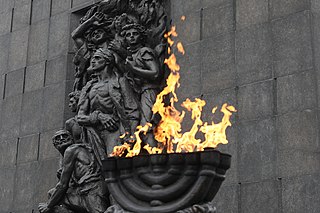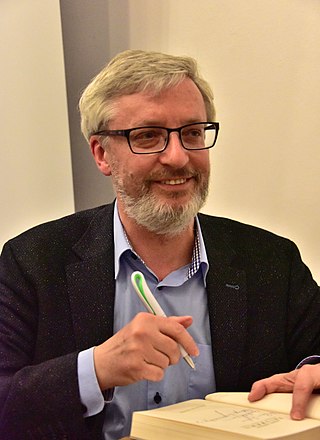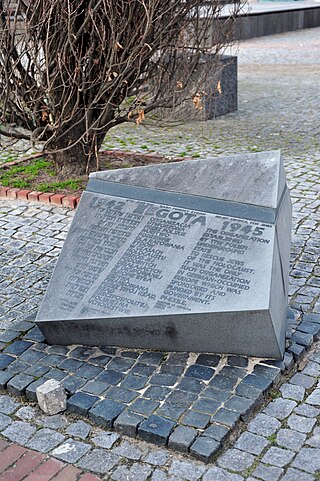
Otwock is a city in the Masovian Voivodship in east-central Poland, some 23 kilometres (14 mi) southeast of Warsaw, with 44,635 inhabitants (2019). Otwock is a part of the Warsaw metropolitan area. It is situated on the right bank of Vistula River below the mouth of Świder River. Otwock is home to a unique architectural style called Świdermajer.

Pruszków is a city in east-central Poland, situated in the Masovian Voivodeship since 1999. It was previously in Warszawa Voivodeship (1975–1998). Pruszków is the capital of Pruszków County, located along the western edge of the Warsaw urban area.

The history of the Jews in Poland dates back at least 1,000 years. For centuries, Poland was home to the largest and most significant Ashkenazi Jewish community in the world. Poland was a principal center of Jewish culture, because of the long period of statutory religious tolerance and social autonomy which ended after the Partitions of Poland in the 18th century. During World War II there was a nearly complete genocidal destruction of the Polish Jewish community by Nazi Germany and its collaborators of various nationalities, during the German occupation of Poland between 1939 and 1945, called the Holocaust. Since the fall of communism in Poland, there has been a renewed interest in Jewish culture, featuring an annual Jewish Culture Festival, new study programs at Polish secondary schools and universities, and the opening of Warsaw's Museum of the History of Polish Jews.

Szymon Datner was a Polish historian, Holocaust survivor and underground operative from Białystok, best known for his studies of the Nazi war crimes and events of The Holocaust in the Białystok region. His 1946 Walka i zagłada białostockiego ghetta was one of the first studies of the Białystok Ghetto.

Brzeziny is a town in Poland, in Łódź Voivodeship, about 20 kilometres (12 mi) east of Łódź. It is the capital of Brzeziny County and has a population of 12,326 as of December 2021. It is situated on the Mrożyca River within the historic Łęczyca Land.
Zew Wawa Morejno was a Polish and American rabbi. He was the last rabbi of the communist People's Republic of Poland, in 1973 emigrating from Poland to the United States without naming a successor.
Anti-Jewish violence in Poland from 1944 to 1946 preceded and followed the end of World War II in Europe and influenced the postwar history of the Jews as well as Polish-Jewish relations. It occurred amid a period of violence and anarchy across the country, caused by lawlessness and anti-communist resistance against the Soviet-backed communist takeover of Poland. The estimated number of Jewish victims varies and ranges up to 2,000. In 2021, Julian Kwiek published the first scientific register of incidents and victims of anti-Jewish violence in Poland in 1944–1947, according to his calculations, the number of victims was at least 1,074 to 1,121. Jews constituted between 2% and 3% of the total number of victims of postwar violence in the country, including the Polish Jews who managed to escape the Holocaust on territories of Poland annexed by the Soviet Union, and returned after the border changes imposed by the Allies at the Yalta Conference. The incidents ranged from individual attacks to pogroms.

Łomazy is a village in Biała Podlaska County, Lublin Voivodeship, in eastern Poland. It is the seat of the gmina called Gmina Łomazy. It lies approximately 16 kilometres (10 mi) south of Biała Podlaska and 84 km (52 mi) north-east of the regional capital Lublin.

POLIN Museum of the History of Polish Jews is a museum on the site of the former Warsaw Ghetto. The Hebrew word Polin in the museum's English name means either "Poland" or "rest here" and relates to a legend about the arrival of the first Jews to Poland. Construction of the museum in designated land in Muranów, Warsaw's prewar Jewish quarter, began in 2009, following an international architectural competition won by Finnish architects Rainer Mahlamäki and Ilmari Lahdelma.

The Będzin Ghetto was a World War II ghetto set up by Nazi Germany for the Polish Jews in the town of Będzin in occupied south-western Poland. The formation of the 'Jewish Quarter' was pronounced by the German authorities in July 1940. Over 20,000 local Jews from Będzin, along with additional 10,000 Jews expelled from neighbouring communities, were forced to subsist there until the end of the ghetto history during the Holocaust. Most of the able-bodied poor were forced to work in German military factories before being transported aboard Holocaust trains to the nearby concentration camp at Auschwitz where they were exterminated. The last major deportation of the ghetto inmates by the German SS – men, women and children – between 1 and 3 August 1943 was marked by the ghetto uprising by members of the Jewish Combat Organization.

The Łomża Ghetto was a Nazi ghetto created by on 12 August 1941 in Łomża, Poland; for the purpose of persecution of Polish Jews. Two months after Operation Barbarossa, the invasion of the Soviet Union, the Jews were ordered to move there in a single day, resulting in panic at the main entry on Senatorska Street adjacent to the Old Market. The number of Jewish men, women, and children forced into the ghetto ranged from 10,000 to 18,000. The survivors of anti-Jewish pogroms, murders, and expulsions in Jedwabne, Stawiski, Wizna, and Rutki-Kossaki, as well as refugees from other locales, were interned in the ghetto. Often, six families were housed there in a single room. The Ghetto was liquidated a year-and-a-half later on 1 November 1942, when all prisoners were transported aboard Holocaust trains to Auschwitz-Birkenau for extermination.

The Central Committee of Polish Jews also referred to as the Central Committee of Jews in Poland and abbreviated CKŻP, was a state-sponsored political representation of Jews in Poland at the end of World War II. It was established on 12 November 1944, as the successor of the Provisional Central Committee of Polish Jews formed a month earlier under the umbrella of the communist Polish Committee of National Liberation (PKWN). The CKŻP provided care and assistance to Jews who survived the Holocaust. It legally represented all CKŻP-registered Polish Jews in their dealings with the new government and its agencies. It existed until 1950 when, together with the Jewish Cultural Society, representatives of CKŻP founded the Socio-Cultural Association of Jews in Poland.

Grzegorz Berendt is a Polish historian. He is a professor at the University of Gdańsk and affiliated with the Institute of National Remembrance. Berendt is the director of the Museum of the Second World War.

Jacek Leociak is a Polish literary scholar and historian as well as author. He is a professor of humanities and an employee of the Institute of Literary Research at the Polish Academy of Sciences and the Polish Center for Holocaust Research in Warsaw.

Marian Turski is a Polish historian, journalist and Holocaust survivor who served as the editor-in-chief of Sztandar Młodych, a nationwide daily newspaper of the Union of Polish Youth in 1956–1957 and from 1958 onwards, a columnist for the moderately critical weekly Polityka as the head of the weekly's historical department.
CENTOS was a Polish-Jewish children's-aid society. Founded in 1924, it became a "leading organization for Jewish childcare" in the Second Polish Republic and was highly active in the Warsaw Ghetto during The Holocaust in Poland.

The Żegota Monument is a stone monument dedicated to the Żegota organization, which rescued Jews during the Holocaust in Poland. It is on Anielewicza Street in Warsaw in the Muranów neighborhood of Warsaw, Poland, near the Monument to the Ghetto Heroes and the POLIN Museum of the History of Polish Jews.

Mirosław Tryczyk is a Polish philosopher, writer, reporter, and Holocaust researcher.















